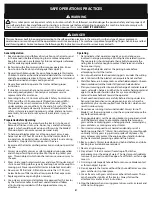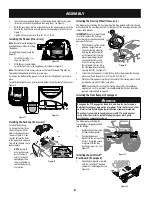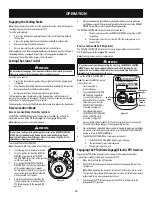
14
OPERATION
3.
Engage the tractor’s parking brake.
4.
Push the throttle control upward, past the detent, to engage the choke.
Note:
If the engine is warmed up, it may not be necessary to choke the
engine.
5.
Turn the ignition key clockwise to the START position. After the engine starts,
release the key. It will return to the NORMAL MOWING position.
CAUTION
Do NOT hold the key in the START position for longer than ten seconds at a
time. Doing so may cause damage to your engine’s electric starter.
6.
As the engine warms up, gradually pull the throttle/choke control lever
rearward past the choke detent position. Do not use the choke position to
enrich the fuel mixture, except as necessary to start the engine.
7.
Allow the engine to run for a few minutes at mid-throttle before putting the
engine under load.
Note:
When operating the tractor be certain that the throttle lever is always
in the FAST position.
8.
Observe the hour meter/indicator panel. If the battery indicator light or oil pressure
light comes on, immediately stop the engine. Have the tractor inspected by your
authorized service dealer.
Turn-Key Ignition with Electronic Governor Control
1.
Insert the ignition key into the ignition switch.
2.
Place the PTO (Blade Engage) switch or PTO (Blade Engage) lever in the OFF
position.
3.
Engage the tractor parking brake.
4.
Set the Electronic Governor Control dial to the desired engine speed setting.
Note:
If the tractor is equipped with an Electronic Governor Control, the tractor
can be started at any speed setting along the dial and will automatically adjust
to the desired engine speed setting.
5.
Turn the ignition key clockwise to the START position. After the engine starts,
release the key. It will return to the NORMAL MOWING position.
Note:
It may take a few seconds after starting for the engine to adjust to the
proper engine speed. This is normal.
PBS Ignition
1.
Place the PTO (Blade Engage) switch or PTO (Blade engage) lever in the OFF
position.
2.
Insert the ignition key.
3.
Engage tractor parking brake.
4.
Move the throttle into the FAST position.
5.
Press the ignition key.
Note:
When operating the tractor be certain that the throttle lever is always
in the FAST position. Operating with the throttle at less than full throttle may
lead to shortened battery life.
Cold Weather Starting
When starting the engine at temperatures near or below freezing, ensure the correct
viscosity motor oil is used in the engine and the battery is fully charged. Start the
engine as follows:
1.
Be sure the battery is in good condition. A warm battery has much more
starting capacity than a cold battery.
2.
Use fresh winter grade fuel. Winter grade gasoline has higher volatility to
improve starting. Do not use gasoline left over from summer.
3.
Follow the previous instruction for Starting the Engine.
Using Jumper Cables To Start Engine
WARNING
Batteries contain sulfuric acid and produce explosive gasses. Make certain the
area is well ventilated, wear gloves and eye protection, and avoid sparks or
flames near the battery.
If the battery charge is not sufficient to crank the engine, recharge the battery. If a
battery charger is unavailable and the tractor must be started, the aid of a booster
battery will be necessary. Connect the booster battery as follows:
1.
Connect the end of one cable to the disabled tractor battery’s positive
terminal; then connect the other end of that cable to the booster battery’s
positive terminal.
2.
Connect one end of the other cable to the booster battery’s negative terminal;
then connect the other end of that cable to the frame of the disabled tractor,
as far from the battery as possible.
3.
Start the disabled tractor following the normal starting instructions previously
provided; then disconnect the jumper cables in the exact reverse order of their
connection.
4.
Have the tractor’s electrical system checked and repaired as soon as possible to
eliminate the need for jump starting.
Stopping the Engine
1.
If the blades are engaged, place the PTO (Blade Engage) switch or PTO (Blade
Engage) lever in the OFF position.
2.
Engage the tractor parking brake.
3.
Place the throttle control to midway between the FAST and SLOW positions.
4.
Turn the ignition key counterclockwise to the STOP position or on PBS units,
press or remove the ignition key.
Driving The Tractor
WARNING
Keep all movement of the Forward and Reverse drive pedals and brake pedal
slow and smooth. Abrupt movement of the drive pedals or brake pedal can affect
the stability of the tractor and could cause the tractor to flip over, which may
result in serious injury or death to the operator.
1.
Depress the brake pedal to release
the parking brake. Move the throttle
into the FAST position.
2.
To travel FORWARD, slowly depress
the forward drive pedal (a) forward
until the desired speed is achieved.
See Figure 27.
3.
To travel in REVERSE, check that
the area behind is clear then slowly
depress the reverse drive pedal (b)
until the desired speed is achieved.
See Figure 27.
WARNING
• Sharp turns can affect control of the tractor. ALWAYS slow the tractor
before making sharp turns.
• Do not leave the seat of the tractor without first placing the PTO (Blade
Engage) in the DISENGAGED (OFF) position and engaging the parking
brake. If leaving the tractor unattended, also turn the engine off and
remove the ignition key.
(b)
(a)
Figure 27















































